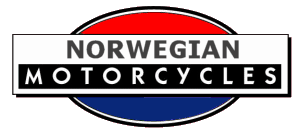

Notes on lesser known Norwegian marques
This page lists brands for which we currently have limited information.
For a more complete listing visit the Index of Norwegian Motorcycles.
Atlanta 1926-1929
Basse Hveem 1940s-1950s
Columbia spesial
Marketed by Columbia sykkeldepot of Youngsgt, Oslo in the 1960s, these were motocross machines powered by Sachs 125 and Villiers 250cc engines. The motorcycles were constructed by Samsing and Finn Lysebråte. The company was later absorbed by Jakob Øglænd.
Source: Norskproduserte Motorsykler
Fantom 1950s
Gladiator
Manufactured by K.G. Karlsson of Sweden at his bicycle factory in Moss, Norway, the Gladiator was fitted with a single-cylinder Moser engine of 2 hp in two versions, one of which had sprung front forks. In 1913 the 2¾ hp and 3½ hp singles were joined by a twin-cylinder model which had a much stronger frame.
The motorcycles were quite expensive, and it is thought that other makes of engine may also have been fitted. Brochures were printed in German and Russian, as well as Norwegian.
The company failed in 1919.
Source: Norskproduserte Motorsykler
Gnom c.1943~1950s
Gresvig
Gresvig of Oslo had the agency for the Mustad Folkescooter in Norway. It is believed these were assembled at the Gresvig factory in Strømsvegen, and used AMO engines. Gresvig also marketed a moped under their own name which was designed by Bjarne Christiensen, one of those responsible for the Mustad.
Sources: Norskproduserte Motorsykler, mop-ed.se.
J.H.Ø 1960s-1970s
Jones
Manufactured in Bergen by F.G. Amundsen using Sachs 98cc engines, these were produced around the mid 1930s. The parts were sourced mainly from Øglænd.
Source: Norskproduserte Motorsykler
Jørum special
Built in Namdalen, probably in the late 1930s. Powered by an EBE 1919 engine of 140cc and fitted with a Burman model C gearbox. The fuel tank, exhaust system, chain case, footrests and many minor componenents were produced in-house. Front motor mount comes from a door lock. Nothing on the machine is welded, everything is either soldered or riveted. Probably a one-off.
Source: Norskproduserte Motorsykler
Messell 1950s
Mundus (Norway)
John Olaf Anderson ran the Cycle & Sports business A\S Mundus in Verdalen (@550km east of Oslo) around 1910. He sold bicycles and motorcycles under the Mundus brand. The Mundus bicycle engines were imported from the Elleham firm in Denmark, and it is thought that Anderson may have assembled complete machines.
Source: Norskproduserte Motorsykler
National
Manufactured by Aktieselskabet Norsk Bicyclefabrik Kristiania at Ekeberg (between Svingensgate and Ryenbergveien) in 1907.
The factory was founded in 1896 and was to produce bicycles. A sizeable plot of land was purchased, they built a large factory and invested in very modern machinery. The production never became profitable and the company went bankrupt, with the slump of 1907 quite possibly a strong factor. The investors suffered heavy losses.
Source: Norskproduserte Motorsykler
Nidaros c.1914~1958
NSU (Brandval) 1957~1961
NV (Norway) 1957

Olympic
Marketed from 1959 to 1967 by Axel Bruun of Trondheim, these were mostly rebranded imports, though it appears some were built in their own bicycle factory.
Their 1964 Corvette de Luxe 240, for instance, is identical to the Tempo of 1961, other than the badge.
Source: mo-ped.se
Raufoss 1958~1966
Real
Manufactured by P. Øie Stordalen per Ålesund. These off-road motorcycles were built before WWII using parts sourced from Øglænd, but with its own tank and a Villiers engine. He also sold machines under the Solo brand.
Source: Norskproduserte Motorsykler
Regent
Produced by G. L. Skahjem of Oslo in the 1930s, the Regent concern was a bicycle and sports shop in Pilestredet 39D. Their motorcycle was powered by a 98cc Sachs engine and weighed 60 kg. In an advertisement from 1934 it is referred to as "the all-rounder's motorcycle with a specially built frame, balloon tyres and engine with gears and neutral".
Source: Norskproduserte Motorsykler
Samsing 1950s-1960s
Sontum
Oscar Engstrøm, a foreman at bicycle importer C.S. Sontum, built a motorcycle in 1903 which is displayed at the Norwegian Vehicle History Museum in Lillehammer. An Engstrøm is listed in the vehicle register and is probably the same machine.
Source: Norskproduserte Motorsykler
Spanjola V4 1922
Staffett 1953-c.1960
Svitun 1950s~1980s
Tjøsvoll Hjulet 1928~1930s
Troll 1967
WeOl
Fred Olsen, a Bultaco importer and leading light in Observed Trials in Norway, joined forces with Rolf Welde to construct trials machines. Welde built the frames, and Olsen developed the engines which were initially from Tempo and later from Sachs. The 200cc Sachs engines were expanded to 204 and 208cc using Saab pistons. Forks were from JØS and Ceriani. At least 5 motorcycles were created. All have disappeared into the mists.
Source: Norskproduserte Motorsykler